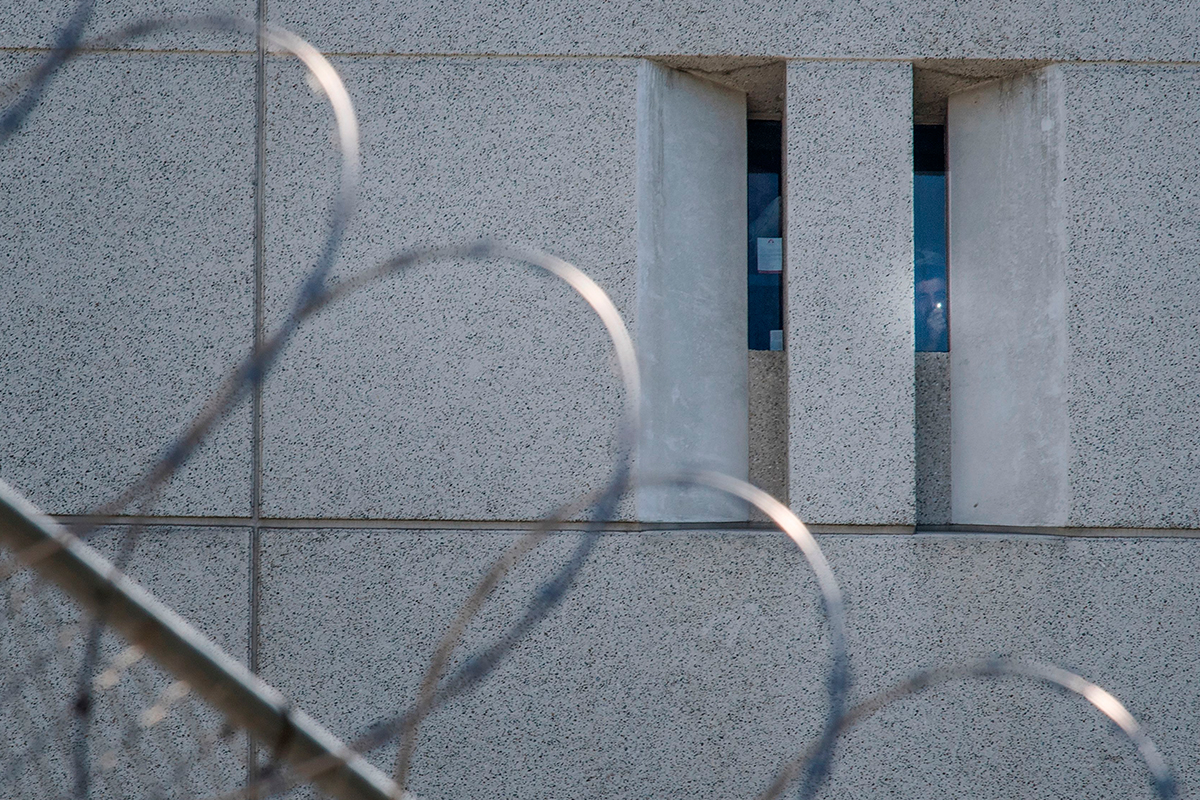Once again, I am here, writing about why people are calling ICE detention centers “concentration camps.” Once again, I am discussing the comparisons between the Holocaust, Nazi Germany, and modern America. Once again, I am filled with anger, an anger that seems to mount every time a new revelation about the horrors of ICE is released.
Let’s back up: Yesterday, September 14, a whistleblower, Dawn Wooten, who previously worked as a nurse at an Immigration and Customs Enforcement (ICE) detention facility in Georgia alleged that high rates of hysterectomies (uterus removals) were being performed on women in custody. (You can read the full complaint here.) In the complaint, it details that women who went to a gynecologist with an ovarian cyst often left with a hysterectomy.
Wooten details one case in particular: “She was supposed to get her left ovary removed because it had a cyst on the left ovary; he took out the right one. She was upset. She had to go back to take out the left and she wound up with a total hysterectomy. She still wanted children—so she has to go back home now and tell her husband that she can’t bear kids… she said she was not all the way out under anesthesia and heard him [doctor] tell the nurse that he took the wrong ovary.”
This is, to put it simply, horrific.
In the text of the complaint put forth by Project South, one woman told the non-profit organization, “When I met all these women who had had surgeries, I thought this was like an experimental concentration camp. It was like they’re experimenting with our bodies.”
Read that sentence again: “This was like an experimental concentration camp.”
The outrage on Twitter and elsewhere was swift, with many people bringing up the history of forced sterilization in the U.S. and comparing the medical abuse of women to what happened in the Holocaust. “Mengele” even briefly trended on Twitter — referring to Nazi doctor Josef Mengele, AKA “The Angel of Death,” known for performing deadly and inhumane experiments on prisoners at Auschwitz — which is simply not something I ever want to log on and see.
This isn’t the first time ICE detention centers have been compared to concentration camps, though the reaction this time feels markedly different. It’s a lot to take in, so let’s break it all down.
When did this comparison first come up?
In 2018, a debate started, largely on the internet, over whether or not it was fair to compare the current U.S. border separations policy with the Holocaust — a comparison that many people were making, and many others were upset by.
The debate was sparked by an April 2018 policy, when then-Attorney General Jeff Sessions announced a “zero-tolerance” policy on “illegal immigration.” Images started coming out of children detention centers — three words that should never be placed together.
The arguments for comparing what happened in Nazi Germany to what is happening in modern day United States focused then on three key points: the concept of “illegality,” the idea that we’re already on the road to another genocide, and a frustration with the focus on the semantics of the comparison. The comparison also hinges on the “just following orders” parallels between ICE and the Gestapo, as well as the similarities in language and visuals of it all. (You can read more here.)
Yet, for all the people tweeting and writing about comparisons between the Holocaust and what was/is currently happening on the U.S. border with Mexico, there were many vocal people who believed the comparison is invalid and unnecessary. Their arguments focused on the idea that the comparison minimizes Jewish trauma, ignores American history, detracts from what is actually happening, and that however awful we feel about the situation at the border, it is not genocide. (Again, more here.)
Wait, didn’t AOC have something to do with it?
Yes. A year later, the debate over the comparison reignited when U.S. Representative Alexandria Ocasio-Cortez said that the detention centers holding undocumented immigrants are “concentration camps.” In an Instagram Live, she said, “I want to talk to the people that are concerned enough with humanity to say that ‘never again’ means something.” (You can read reactions to those comments here.)
It was around this time many people pointed out that Nazis didn’t invent concentration camps; the English term “concentration camp” was first used to refer to camps set up by the Spanish military in Cuba during the Ten Years War in 1868. Many others brought up the fact that we don’t need to look outside of U.S. history for comparisons of genocide and ethnic cleansing. See: the history of Indigenous Americans.
How are we here, again?
When the whistleblower complaint about mass hysterectomies came out, many on Twitter reacted by essentially saying: Can we stop arguing about semantics now? They’re concentration camps, and we need to be outraged.
"Mass hysterectomies."
We still on the fence about where we are re:Nazi Germany? Still in our feelings about the language of "concentration camps"?https://t.co/mJZJeui7aD— (((Ma Nishtana))) (@MaNishtana) September 15, 2020
A lot of Jewish figures and organizations were vocal in denouncing @AOC's comparisons of immigration detention facilities to concentration camps.
I hope they will be at least equally vocal in denouncing the atrocities at those facilities that make the comparison seem apposite.
— R. P. Schwartz (@Doc_RPS) September 14, 2020
What else are people saying?
Here are some tweets that speak for themselves:
I’m a Jew. Comparing contemporary occurrences to concentration camps is dangerous. And that’s what these are.https://t.co/2rTtK8hb7n
Never Again Is Now.#AbolishICE, end immigration detention, and mandate legal immigration status priority to ICE detainees and their families. pic.twitter.com/sDdIqVrV7p
— Anti-Fascist AWK (@AWKWORDrap) September 14, 2020
I never want to hear "oh you're just overreacting" when we compare the border camps to concentration camps.
"There were mass hysterectomies"
— Michael Swartz (@Maswartz226) September 14, 2020
The forced sterilization at ICE facilities is unfortunately the natural progression everyone warned about when everyone made the connection to them and concentration camps a few years back
— Daniel Alvarenga (@_danalvarenga) September 14, 2020
This is why we’ve been calling them concentration camps. Because they are.
Forced hysterectomies are literally a genocidal move. This is genocide. These are concentration camps. https://t.co/MC3Lhi6KDV
— Lilith (they/them) (@lilithxsinclair) September 14, 2020
Everyone who told me that the Nazi comparisons “weren’t appropriate” can kiss my entire Hebraic ass. I want an administration that doesn’t think Josef Mengele is someone to emulate & I don’t feel like that’s a lot to ask. This is absolutely horrific. https://t.co/Ef9yqcEc7X
— The Sassiest Semite (@LittleMissLizz) September 14, 2020
Has anything like this happened in the United States before?
Yes, sadly. Forced sterilization — which is what is happening with forced hysterectomies, removing a woman’s ability to bear children — has a long history in the U.S. as a means of white supremacist violence.
Absolutely evil. This country has a long history of forced sterilization and eugenics, not surprising that ICE is bringing back this old American tradition. Mengele shit. https://t.co/d0ndLtTUJC
— Sam (@halaljew) September 14, 2020
As Representative Ayanna Pressely tweeted, “Forced sterilization is a cruel tool of white supremacy with a long, abominable history in this country.”
Similarly, Ilyse Hogue, CEO of NARAL Pro-Choice America, tweeted: “A whistleblower at ICE today exposed that mass hysterectomies are being performed on detained immigrants. If it sounds like a horror show, that’s because it is. Gender oppression has a direct correlation with authoritarianism. This is beyond. The vicious cruelty is staggering.” Hogue then linked to a history of coerced sterilization in U.S. history, which details how “coerced sterilization is a shameful part of America’s history,” from forced sterilization of Native American women throughout the 20th century to the forced sterilization of female inmates in California between 2006 through 2010.
So while the Holocaust comparison is apt, remember: This is a part of American history. We can’t look away.
What can I do?
1. Here are three concrete ways to help families separated at the border.
2. Consider supporting Project South, the organization that is representing the whistleblower.
A courageous nurse at Irwin Country Detention Ctr is speaking out about abuses, racism and #COVID19 hazards for detainees and guards: https://t.co/Ne3dLZtmWC
We & @GovAcctProj are representing her & have filed complaint w/DHS Office of Inspector General: https://t.co/1HPQl96PVP
— Project South (@ProjectSouth) September 14, 2020
3. Call your representatives.
4. Vote — early, by mail, on election day.
5. Join protests to close the camps.
Header image: A prisoner shines a torch from the main ICE detention center in downtown Los Angeles, California on July 14, 2019. Photo by MARK RALSTON/AFP via Getty Images.



